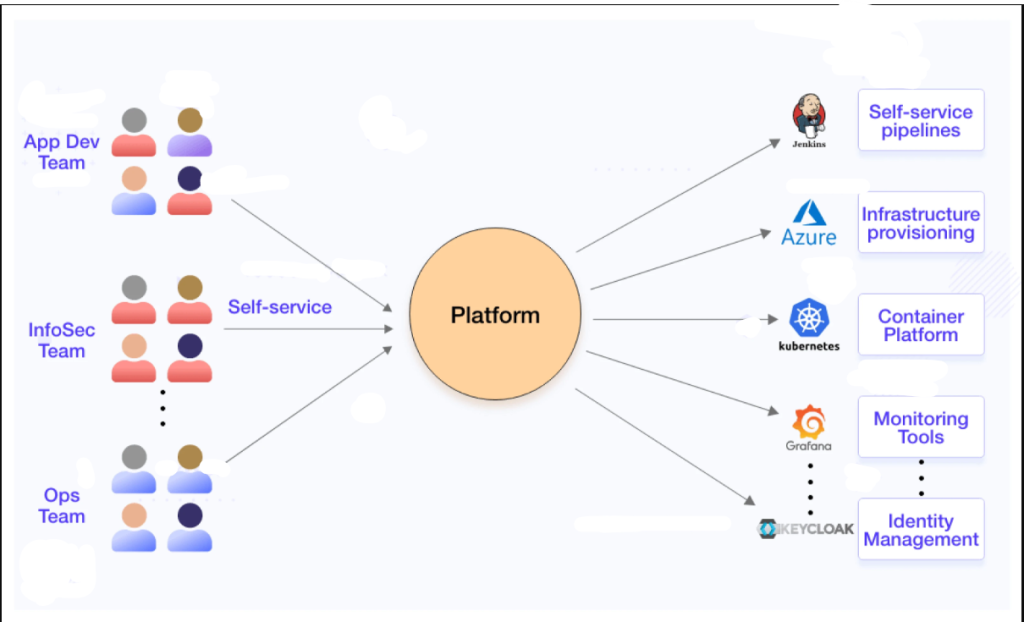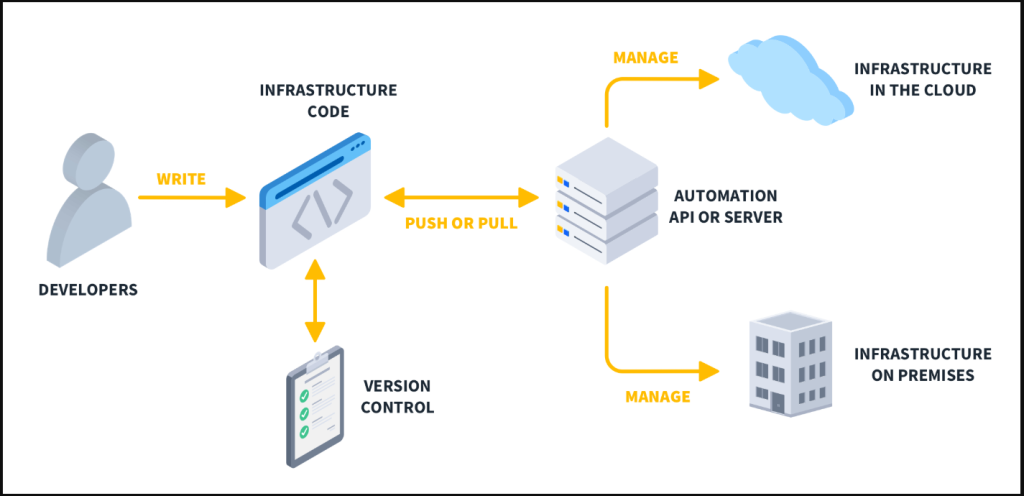
Here’s a detailed guide for a comprehensive post titled “How to Build a Self-Service Platform Engineering Model for DevOps” with expanded content:
Understanding the Need for a Self-Service Platform in DevOps
In today’s fast-paced DevOps world, efficiency and scalability are paramount. As organizations scale, the complexity of managing environments, deploying applications, and handling infrastructure increases. A self-service platform engineering model enables DevOps teams to operate more independently, automating manual tasks, and streamlining workflows. It not only reduces the burden on platform engineers but also empowers development teams to manage their own infrastructure without needing deep expertise in platform management.
Building a self-service platform in DevOps allows developers and operators to provision, configure, and deploy resources autonomously. This approach accelerates the development lifecycle, fosters innovation, and ensures faster turnaround times for releases.
Key Features of a Self-Service Platform Engineering Model
- Autonomous Resource Management: Developers can provision and manage resources without depending on operations teams.
- Automation and Self-Healing: Automates infrastructure provisioning, scaling, and self-healing to minimize manual intervention.
- Standardized Environments: Ensures consistent and repeatable environments across development, testing, and production stages.
- Security and Compliance: Embeds security and compliance checks in self-service workflows to ensure governance.
- Ease of Use: Simple interfaces and clear workflows that enable developers to easily interact with infrastructure tools.
1. Define Clear Objectives for the Self-Service Platform
Before developing a self-service platform engineering model, it’s essential to define clear objectives. What do you want to achieve with the platform? Whether it’s faster development cycles, more efficient resource management, or better collaboration between teams, identifying the specific goals will shape how the platform is designed and implemented.
Steps for Defining Clear Objectives
- Identify Pain Points: Understand the challenges faced by development teams, such as delays in provisioning resources or manual deployment processes.
- Set Measurable Goals: Define KPIs like reduced provisioning time, fewer support tickets, or increased deployment frequency to measure success.
- Engage Stakeholders: Involve developers, operations, and security teams in the goal-setting process to ensure that all needs are considered.
- Align with Business Goals: Ensure that the platform engineering model aligns with the company’s broader business objectives, such as faster product releases or improved security.
- Focus on Developer Experience: Prioritize simplicity, user-friendliness, and support for self-service capabilities to improve the overall developer experience.

2. Automate Infrastructure Provisioning with Infrastructure as Code (IaC)
Automation is a core component of a self-service platform. By using Infrastructure as Code (IaC) tools like Terraform, CloudFormation, or Ansible, you can automate the provisioning, configuration, and scaling of infrastructure resources. This allows developers to request and provision infrastructure resources without manual intervention from platform engineers.
Best Practices for Automating Infrastructure
- Use IaC Tools: Choose tools that enable the definition of infrastructure through code, ensuring consistency across environments.
- Create Reusable Templates: Develop reusable infrastructure templates that developers can modify for different use cases, ensuring scalability and flexibility.
- Automate Provisioning: Automate the provisioning of resources such as virtual machines, databases, networking, and storage, allowing developers to self-serve without intervention.
- Version Control IaC Scripts: Store infrastructure code in version control (e.g., Git) to enable tracking, collaboration, and rollback when necessary.
- Implement CI/CD for IaC: Integrate infrastructure code into CI/CD pipelines to automate the validation and deployment of infrastructure changes.
3. Provide Self-Service Tools for Developers
For a self-service model to be effective, developers need the right tools to interact with infrastructure and deploy applications. The platform should provide an easy-to-use interface that allows developers to request resources, deploy applications, and manage their environments without needing platform engineers’ involvement.
Key Tools for Enabling Self-Service
- Portal for Resource Management: Develop a web-based portal or CLI tools where developers can request infrastructure resources, manage configurations, and view metrics.
- API Access: Provide APIs that developers can use to automate interactions with the platform, enabling programmatic access to provisioning, monitoring, and deployment.
- Pre-Built Templates: Provide templates for common infrastructure configurations, allowing developers to quickly deploy standard environments without having to build them from scratch.
- Integrated Monitoring and Logging: Offer integrated monitoring tools, such as Prometheus or Datadog, to allow developers to track resource performance and health.
- Self-Serve Deployment Pipelines: Enable developers to create and manage their own CI/CD pipelines that integrate with the platform to automate deployment and testing.
4. Implement Access Control and Governance
While a self-service platform empowers developers, it is essential to ensure that security and governance are maintained. By implementing strict access controls and security policies, enterprises can prevent unauthorized access and ensure compliance with internal and external regulations.
Best Practices for Governance and Security
- Role-Based Access Control (RBAC): Implement RBAC to manage who can access certain resources. For example, only authorized personnel can modify production environments or access sensitive data.
- Automated Compliance Checks: Embed automated security and compliance checks into the self-service platform to ensure that developers follow company policies and regulatory requirements.
- Audit Logging: Enable logging of all actions within the platform to provide an audit trail for tracking changes and detecting unauthorized access or configuration changes.
- Set Resource Limits: Define resource quotas and limits to prevent runaway costs or accidental over-provisioning of resources, ensuring that developers have access to the resources they need without breaching policies.
- Regular Security Scanning: Use tools like Snyk or Checkmarx to scan for vulnerabilities in the code, infrastructure, and dependencies, automatically blocking insecure deployments.
5. Provide Comprehensive Documentation and Training
A successful self-service platform requires thorough documentation and training to ensure developers are able to utilize it effectively. Clear instructions and resources will reduce confusion, accelerate adoption, and encourage efficient use of the platform’s capabilities.
Key Elements of Documentation and Training
- Step-by-Step Guides: Provide easy-to-follow, step-by-step guides for developers on how to request resources, configure environments, and deploy applications.
- Code Examples: Offer code samples for common use cases, such as provisioning databases, setting up virtual machines, or deploying web applications.
- Troubleshooting Documentation: Create a comprehensive troubleshooting guide to help developers resolve issues independently, reducing dependency on support teams.
- Internal Wiki or Knowledge Base: Maintain an up-to-date internal knowledge base or wiki that contains FAQs, tutorials, and best practices for using the platform.
- Training Sessions: Organize regular workshops or webinars to onboard new developers and provide ongoing training to ensure everyone stays up to date with platform features and best practices.
6. Monitor, Iterate, and Improve the Platform
Once the self-service platform is implemented, continuous monitoring and iteration are essential to ensure its success. Collect feedback from developers, identify areas for improvement, and make necessary adjustments to meet evolving needs.
Continuous Improvement of the Platform
- Gather User Feedback: Collect regular feedback from developers to understand their pain points and areas where the platform can be improved.
- Monitor Platform Usage: Track usage metrics to identify which features are most popular, where developers are encountering issues, and where resources are being underutilized.
- Iterate and Update: Continuously iterate on the platform, adding new features, improving automation, and refining security protocols based on feedback and evolving technology.
- Track Key Metrics: Measure platform success through metrics such as deployment speed, developer satisfaction, and cost optimization to ensure the platform is delivering value.
- Address Bottlenecks: If developers encounter bottlenecks in their workflows or are unable to self-serve effectively, identify root causes and implement solutions to improve the platform.
The Benefits of Building a Self-Service Platform Engineering Model
Building a self-service platform engineering model for DevOps offers significant benefits in terms of efficiency, autonomy, and scalability. By automating infrastructure provisioning, enabling self-service tools, and embedding governance into workflows, enterprises can empower development teams to work more independently while maintaining control over resources and security.
The key to success lies in aligning the platform with business goals, ensuring that it’s easy to use, and continuously improving it based on feedback and performance data. By following these best practices, organizations can build a self-service platform that drives innovation, speeds up software delivery, and enhances overall developer productivity.
